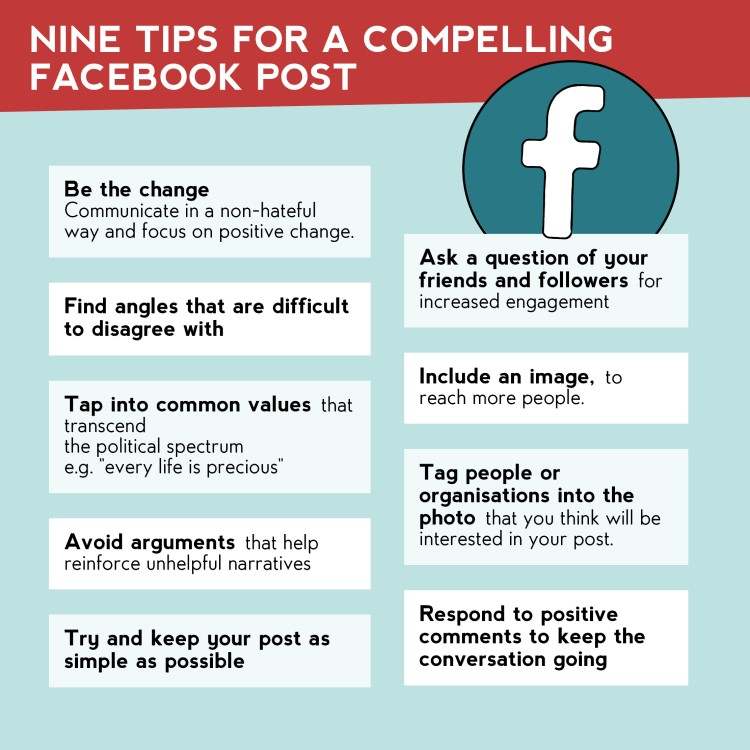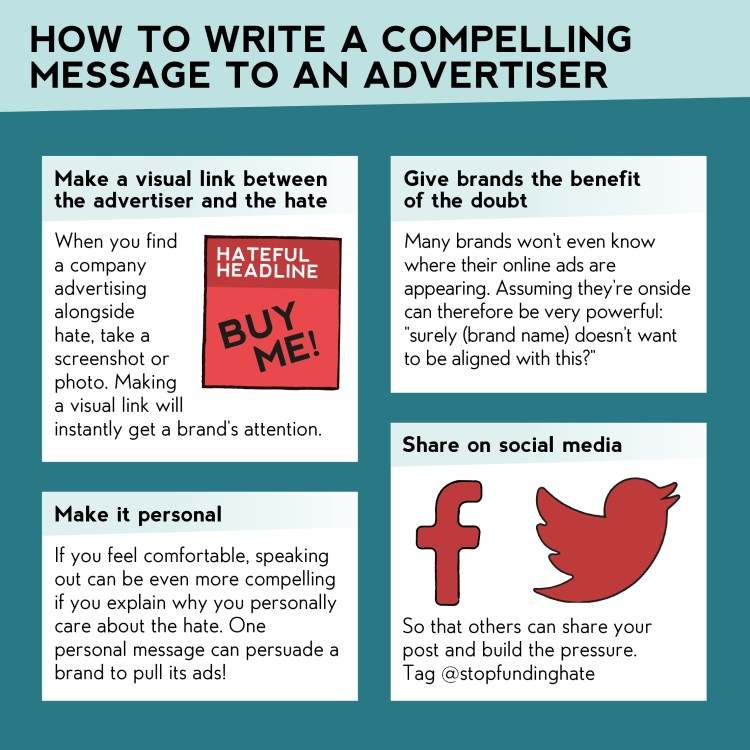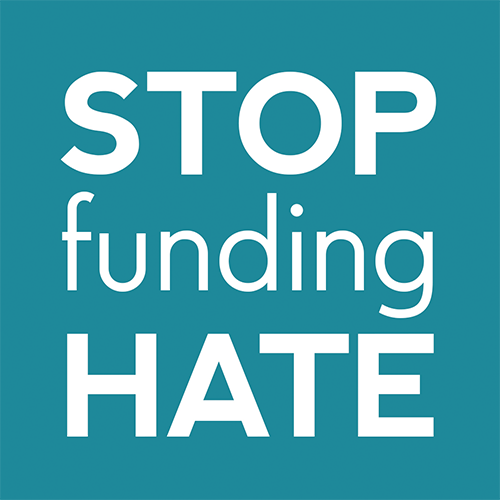With dozens of print newspapers, hundreds of online news and entertainment sites, and thousands of advertisers, how can you make a difference? Fortunately, you don’t need millions of followers or a high-profile position to tackle hatred and discrimination – you just need to use your voice in any way you can, along with the many other Stop Funding Hate supporters who are working alongside you.
Since we started campaigning in 2016, Stop Funding Hate has developed a range of methods that we have found to be effective in persuading brands to pull their advertising from media that publish discriminatory and hateful content. Our Tactics and Tools will help you contact companies in the most effective way.
Getting started
Stop Funding Hate value our supporters’ time and energy, and so we focus on actions where there’s a strong chance of having a real impact. We do this by taking action on the most obvious and extreme examples of media hate that as wide an audience as possible will “get”, and that are the most likely to make brands sit up and take notice.
Some of the examples that fall into this category are:
- Dehumanisation – for example, describing the targeted group as “vermin”, a “swarm”, or an “invasion”
- Language that could incite violence – such as calling people or groups “traitors”, or describing them as a threat that must be “wiped out”
- Anything that pushes a demonstrably false claim painting the targeted group in a negative light – for example, manipulated crime statistics or false crime reports
- Anything that directly endorses discrimination against a protected group – such as comments about “benefits scroungers” in coverage of disabled people
- Where you can show a clear pattern of negative coverage (such as migrants in the Express or the Daily Mail)
- Where a piece of media content is repeating known inflammatory or extremist tropes targeting a particular group – for example, linking migrants to disease, Traveller communities to criminality, or presenting LGBTQ+ people as a threat to children.

Next steps
When you’ve identified a media headline or article that you want to focus on, the next step is to approach an advertiser that is connected to the outlet – for example, a company whose adverts are displayed on a website next to an inflammatory article, or who have bought ad space in a print newspaper with a hateful headline. You can make your approach on social media, or via email or letter, whichever you prefer.
Social media tips:
- Most companies will have accounts on a variety of different platforms, such as Twitter, Facebook and Instagram. Make your own account on the same platform
- Find a specific article or published piece online that has examples of hate speech or discriminatory content
- Find an advertiser or company’s ad on the same page and take a screenshot. Try to make sure that the screenshot includes both the discriminatory comment or headline, and the advertiser or company
- Send a tweet or comment with the screenshot and a short, polite message, tagging the company
- You can also tag @stopfundinghate so that we are notified and can signal-boost; similarly, you can use the hashtag #stopfundinghate for more exposure
- Retweet or like the comments and posts of other supporters and campaigners
- If the company you contact gets back to you, please retweet or share their message and let us know. You can send us a Facebook message, tweet us, or email us at info@stopfundinghate.info
Letters and emails:
If you prefer not to use social media, letters and emails can also be an effective way of approaching companies. Many of the techniques are the same – find an article and advert, and take a screenshot that you can send, if possible – but letters and emails give you more space to go into detail. These may be a better option for when you have to include an explanation of why something less overtly hateful is actually a harmful trope. It also gives you more room to include a personal angle, and your own experiences, which can be highly effective.
Making it personal
Being personally affected by a particular issue or type of hate means that you can use this personal experience to make your approach to an advertiser even more compelling. If you feel comfortable doing so, you can let the company know the ways that online hate affects you.
Of course, you don’t have to have first-hand experience – being an ally and speaking out for others is just as important, and can show a company that a broad cross-section of society is uncomfortable or disappointed about a particular example of media discrimination. If you do not belong to the group being discriminated against, you can give examples of friends, family members or acquaintances who have been affected, or talk about your feelings about how society is better when we stand against hate.
Keep it friendly
While anger is a valid response to any form of discrimination, when you’re approaching companies to pull advertising, we’ve found that the best approach is to keep your message polite and friendly. Many companies, especially for online adverts, won’t know their advert is appearing on a particular site. They’re also more likely to engage with polite comments. If a company responds to you and says they’re pulling their ad, send them an email or message thanking them!

Staying safe
The internet and social media allows us to organise together and use our voices more easily. Unfortunately, it has also brought new ways of communicating negatively. If you’re calling for change on social media, it’s likely you’ll encounter trolls.
Sometimes, just sending a tweet or message can be enough to prompt a barrage of abuse, often from overtly racist or far-right accounts. This kind of abuse becomes more likely if the brand responds to your tweet, or if it gets shared widely. If this happens, there are steps that you can take:
- Don’t reply or engage – trolls will often talk about wanting a “debate”, or say that they’re “just asking questions”, but this is a tactic. Trolls are not interested in genuine discussion – they want to draw you into an engagement that will upset and demoralise you, and help them spread their message
- Block trolls early. No-one is entitled to access to your feed, or your time. If someone is being deliberately antagonistic, or if you simply don’t want to engage with them, then it is completely fine to block them rather than engage. If an account is being abusive, you may also want to report them, or, in the case of death threats or threats of violence, report this to the police
- Be aware that trolls may seek out personal information about you from the public domain. Trolls can seek to attack people by “doxing” them or targeting their employer. If you know that you have sensitive personal information online, it may be better to engage with advertisers through letters or email
- If you are experiencing online abuse, you can find resources for help at Crash Override Network (http://www.crashoverridenetwork.com/), who offer information regarding all forms of online harassment
Self-care
- Online abuse can take its toll. Remember to take regular breaks, give yourself plenty of down time, and use any tools available to filter out responses. Many social media sites will have settings that allow you to hide responses from people you don’t follow, or from new accounts (trolls will often use recently-created accounts to harass other users)
- Organisations such as Glitch have other tips on how to deal with online abuse: https://glitchcharity.co.uk/resources
How you can get more involved
Sharing knowledge of #StopFundingHate’s tactics is a key part of our longer-term strategy for building on the positive changes we’ve seen, and working to bring about a media that treats everyone fairly. Towards this end, we’re now running regular online training workshops, and aim to scale up this work in 2023.
If you’d like to get involved and find out more, please do sign up for one of our upcoming online workshops here.
If you might be interested in volunteering to help develop our knowledge-sharing and training work, please get in touch via volunteers@stopfundinghate.info
